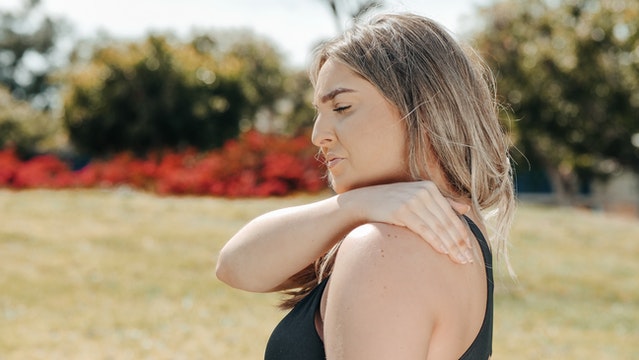Surgery for a rotator cuff tear is a significant operation — it involves sewing the torn tendon and reattaching it onto the bone in the upper arm. Most people suffer from pain and stiffness after the surgery, and recovery is slow. Why? The most common reason is medically restricted use or movement of the arm for at least four weeks. Another cause is stiffness due to movement restriction of the shoulder blade or scapula and the surrounding upper ribs.
Another common cause of gnawing postoperative pain, not controlled by medication or the use of ice, may not be related to the initial injury itself. This pain may be due to how the arm was moved or held during or right after surgery. Your doctor and physical therapist can watch for this and see if it is happening to the degree that isn’t normal. Often this pain is managed through gentle touch and repositioning, and the problem disappears.
Manage The Pain
There are several ways to reduce your pain, and these include:
Breath
Knowing how to use your breath is a natural way to decrease pain and associated muscle spasms around the neck, scapula, and ribs. The first of two types of breathing styles is the long, slow inhale through the nose with a slight abdominal contraction so that the lower belly is not fully expanding during the inhale. This small restriction or increased abdominal tone allows the ribs along the side of the torso and under the armpit to expand. Another type of breathing is called ‘step or stair climbing’ inhalation. Reminiscent of short quick sniffs or inhales is done consecutively four to five times without exhaling between the inhale ‘steps.’ Three to four repetitions, completed three or four times a day, these two types of breath ‘exercises’ are beneficial.
Medicine
Under the prescription and direction of your doctor, you may take pain medicine of some sort, such as anti-inflammatory medications, pain relievers, acetaminophen, and prednisone.
Ice
Inevitably you will experience some degree of muscle spasm, joint stiffness, arm soreness, and swelling in and around the surgical area. Applying an ice pack that conforms to the shape of your shoulder for twenty minutes at a time, three or four times a day, can be beneficial.
Protect Your Shoulder
The goal of shoulder surgery is to reattach ruptured tendons to the bone and remove any excessive osteoarthritis so that you can return to work and play with minimal pain and discomfort. Your role following surgery is to protect your shoulder during all healing phases over the next six months. An immobilizing sling that keeps your upper arm away from your torso stabilizes and restricts shoulder joint movement after surgery. The specialized sling provides a shelf or a stable environment allowing your tendon to scar down and securely reattach itself to the bone. Restricting movement will not damage your tendon.
Sleep
More than likely, you will wear your specialized sling while sleeping. It may be helpful for the first couple of weeks to sleep in a recliner or a broad armchair. This slightly elevated position after rotator cuff surgery helps keep pressure off or diminishes pull on the shoulder joint. Later, you will be able to transition to the bed; sleeping on your back, you may prop yourself up with pillows or use a small incline wedge under the mattress or a small pillow under the elbow.
Ask for Help
While healing and somewhat feeling immobile, be prepared for any additional challenges. That means asking for help from family members or friends who will be available to assist with your recovery, especially with routine hygiene, toileting, dressing, and food preparation.
Somatic Exercises
Somatic education sessions are crucial to a successful recovery. Somatic exercises not only improve the range of motion of the upper ribs, collarbone, or clavicle but gentle passive shoulder blade or scapular movement can also help reduce pain and inflammation. After 6-8 weeks post-surgery, somatic-based exercises or movement patterns can help regain functional movement and strength beyond traditional rotator cuff exercises.
Limit Your Movement Until Appropriate
Even after 12 weeks post-surgery, the bone that holds the tendon in place is still re-modeling or changing. This change is the body’s way of anchoring and ensuring that the tendon holds and does not rupture again. Consider how you can keep yourself from putting undue stress on it. Intelligent movements are just as important during this phase of recovery. For instance, do not force the reach behind your back (yes, you can pull your pants up or tuck your shirt into your pants). Do not lift or carry anything heavy one-handed (a gallon of milk is 8 pounds) or lift your arm overhead. Intermittently wearing a sling can be very helpful in keeping you from inadvertently injuring yourself.
Pace Yourself
It’s common to think you’ve already recovered from your shoulder injury. You may even feel ready to resume sporting activities or take on new challenges. That may be a dangerous mistake. Learning how to interpret the body’s signals of approaching the limitation of the new tendon anchor is just as important as improving the range of motion.
Bottom Line
It takes about six weeks for the repaired rotator cuff tendons to reattach themselves to the bone. However, most people who have had surgery on their shoulder tell you that it takes about nine months before they feel completely normal. Based on a study that shows patients who have had rotator cuff surgery, muscle strength in the shoulder does not fully restore until about nine months after the operation.
While discomfort and some soreness are perfectly normal, the ongoing experience of pain, deep gnawing achiness, and sensations of throbbing after rotator cuff surgery are not.
However, if you would like to maximize your recovery, Fascial Counterstrain and somatic-based movement patterns can be a valuable tool to inhibit excessive inflammation, regain a full range of motion, and facilitate pain-free movement. To begin, book a session with me at 812-344-4119.

